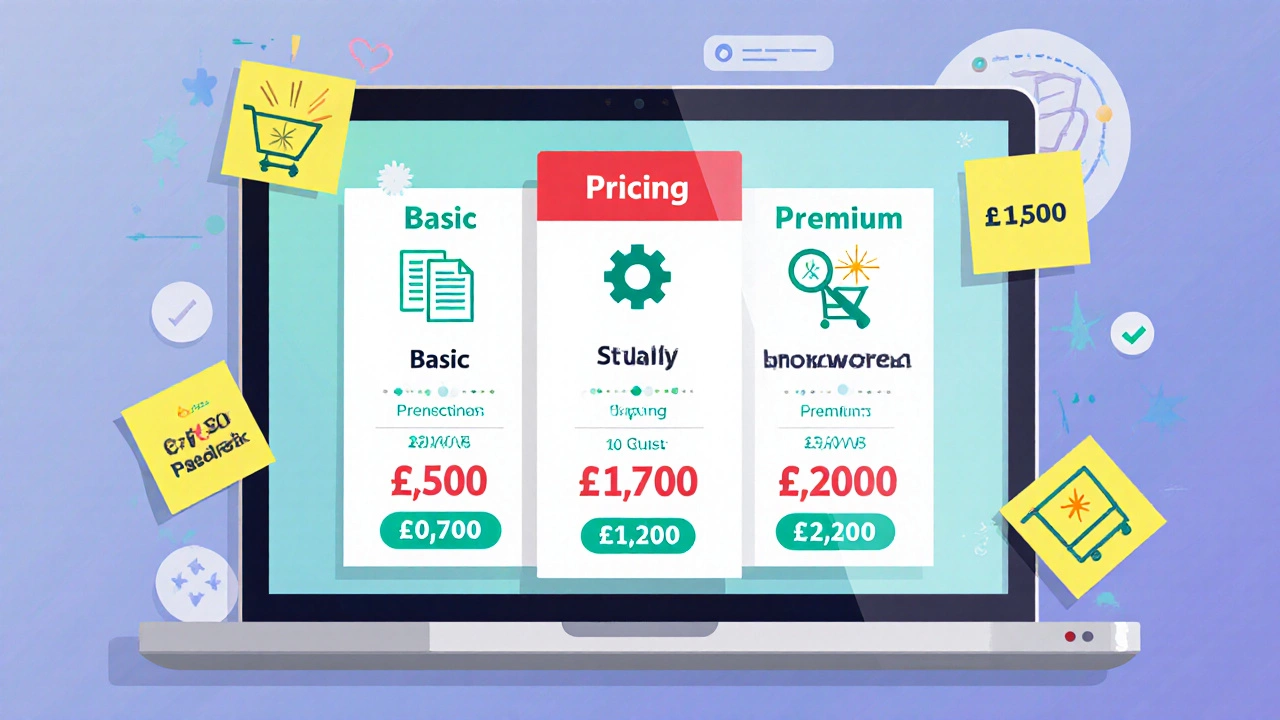Web Designer Pricing Calculator
Tip For most beginners in the UK, aim for rates between £30-£35/hour as your minimum. Most successful beginners charge £45-£60.
Tip Never accept rates below £30/hour or project prices below £400 for a full site - this leads to burnout and undervalued work.
Tip Use tiered pricing (Basic/Standard/Premium) to simplify quotes and upsell services. Show a clear breakdown of hours, rates, and deliverables.
Starting out as a freelance web designer can feel like walking a tightrope - you want to earn enough to cover your bills but also stay competitive enough to land that first client. Beginner web design pricing is the set of strategies and benchmarks that help new designers decide how much to charge for a website project. Below, we break down the exact steps you need to calculate a fair rate, compare the most common pricing models, and avoid the traps that make beginners either under‑price or over‑price themselves.
Key Takeaways
- Figure out your minimum viable hourly rate by adding living costs, business expenses, and a profit margin.
- Choose between hourly and project‑based pricing based on project scope, client type, and your confidence level.
- Use a tiered pricing sheet (basic, standard, premium) to simplify quotes and upsell services.
- Showcase a focused portfolio and clear deliverables to justify higher rates.
- Negotiate with confidence: know your floor price and be ready to walk away if a client pushes below it.
1. Understand the Core Elements That Drive Your Rate
Before you type any numbers into a spreadsheet, map out the ingredients that make up a sustainable price.
- Living cost is the amount you need each month for rent, utilities, food, transport, and taxes in your area. In Birmingham, a modest lifestyle typically requires around £1,800 per month after tax.
- Business expenses include software subscriptions (Adobe, Sketch, Figma), domain hosting, internet, and occasional coworking space fees. Budget roughly £150‑£200 a month.
- Profit margin is the extra percentage you add on top of your costs to grow your business, save for taxes, and build a buffer. Aim for 20‑30% when you’re just starting.
Calculate a baseline hourly rate:
- Total monthly cost = living cost + business expenses = £2,000(rounded).
- Assume you can bill 20hours per week (≈80hours per month) after accounting for admin, learning, and downtime.
- Base hourly = £2,000 ÷ 80 = £25.
- Add 25% profit margin → £31≈£30‑£35 as your minimum viable hourly rate.
If you feel your skill set already exceeds the absolute beginner level, you can comfortably start at £45‑£60 per hour. Anything below £30 puts you at risk of burnout.
2. Hourly vs. Project‑Based Pricing - Which Fits Your First Jobs?
Both models have pros and cons. The right choice often depends on the client’s clarity, the project’s size, and how confident you feel about estimating effort.
| Aspect | Hourly Rate | Project‑Based |
|---|---|---|
| Predictability for client | Low - client sees fluctuating totals | High - fixed price up front |
| Risk for designer | High - scope creep can eat profit | Medium - mis‑estimation can cut margins |
| Ease of quoting | Simple - multiply hours by rate | Requires detailed scope breakdown |
| Suitability for small tasks | Great for Micro‑projects like landing‑page tweaks | Better for full site builds |
| Negotiation leverage | Limited - client pushes hours down | Higher - you set the total budget |
If you’re unsure about estimating a new type of site, start with an hourly contract for the discovery phase, then switch to a project quote once the scope is crystal clear.

3. Build a Tiered Pricing Sheet - Basic, Standard, Premium
A three‑tier sheet lets you answer “How much will this cost?” without endless back‑and‑forth. Here’s a practical template you can copy into Google Sheets.
- Basic - 3‑page brochure site, responsive design, contact form. Price: £500‑£700.
- Standard - up to 8 pages, basic SEO, CMS (WordPress) setup, 2 rounds of revisions. Price: £900‑£1,200.
- Premium - custom UI/UX, e‑commerce integration, advanced SEO, ongoing support for 3months. Price: £1,600‑£2,200.
Adjust the numbers based on your hourly baseline. For example, a 20‑hour Standard project at £45/hour equals £900 - exactly the lower bound of the tier.
When a client asks for something outside the tiers, you can quickly slot it into “Custom” and provide a separate quote.
4. Leverage Your Portfolio and Client Communication
Even a beginner can command higher rates with a focused portfolio. Choose 2‑3 real or mock projects that showcase:
- Clean, responsive layouts.
- Thoughtful typography and colour hierarchy.
- Clear call‑to‑action placement.
Explain each piece in plain language: what the client needed, which tools you used (Figma for prototyping, WordPress for CMS, Adobe Photoshop for assets), and the impact - e.g., “increased newsletter sign‑ups by 30%”. This narrative justifies the higher end of your tier pricing.
5. Negotiation Tips - Know Your Floor and Walk‑Away Point
Clients love to haggle, especially on the first gig. Keep these tactics handy:
- Anchor high. Quote the top of the tier; it makes the lower end seem like a discount.
- Break down the cost. Show a simple table of hours, rates, and deliverables - transparency builds trust.
- Offer a limited‑time discount. If they’re on the fence, a 5% reduction for signing within 48hours feels like a win‑win.
- Stick to your floor. If a client pushes below £30/hour or under £400 for a full site, politely decline. “I appreciate the interest, but I can’t deliver the quality you deserve at that price.”
Remember, a client who undervalues you will likely undervalue the work, leading to scope creep and unpaid revisions.

6. Common Pricing Pitfalls and How to Avoid Them
Even seasoned freelancers slip up. Here’s a quick checklist you can print:
- Don’t quote by the project without a clear scope.
- Avoid “all‑inclusive” pricing that bundles endless revisions - set a limit (e.g., 2 rounds).
- Never forget to add tax (VAT20% in the UK) when invoicing corporate clients.
- Don’t discount yourself just to win a job; use a “first‑client discount” instead of a blanket cheap rate.
- Track every billable minute; otherwise you’ll underestimate future projects.
7. Real‑World Example: From Calculation to Contract
Let’s walk through a hypothetical first client - a local coffee shop needing a 5‑page site.
- Scope: Home, Menu, About, Blog, Contact - responsive design, WordPress CMS.
- Estimated effort: 30hours (design 12h, development 15h, testing 3h).
- Hourly baseline: £45 → 30h × £45 = £1,350.
- Add 10% contingency = £1,485.
- Round to nearest tier: Standard package £1,200 (slightly below estimate) - decide to either negotiate up or reduce scope.
- Quote: "Standard website package - £1,200, includes 2 rounds of revisions, SEO basics, and 3months of support".
- Contract: Include payment schedule - 50% upfront, 25% after design approval, 25% on launch.
The client signs, you deliver on time, and you’ve earned a solid first‑project profit while staying within your calculated rate.
Frequently Asked Questions
What is a realistic hourly rate for a brand‑new web designer in the UK?
Based on living costs in Birmingham and typical business expenses, the minimum viable rate is around £30‑£35 per hour. Most beginners start charging £45‑£60 once they have a few portfolio pieces.
Should I price by the hour or by the project?
Start with hourly contracts for discovery and small tweaks. Move to project‑based quotes once you can clearly define scope. This hybrid approach protects you from scope creep while giving clients price certainty.
How many hours can I realistically bill each month?
For a beginner balancing learning, admin, and client work, 20‑25 billable hours per week (≈80‑100 per month) is a realistic target.
What should I include in my contract to protect my rates?
Specify the total price, payment milestones, number of revision rounds, scope of work, deliverables, and a “out‑of‑scope” clause with hourly add‑on rates. Also list VAT and late‑payment penalties.
Can I offer discounts without devaluing my brand?
Yes, frame them as limited‑time or “first‑client” promotions. Keep the discount amount modest (5‑10%) and always show the original price to maintain perceived value.
